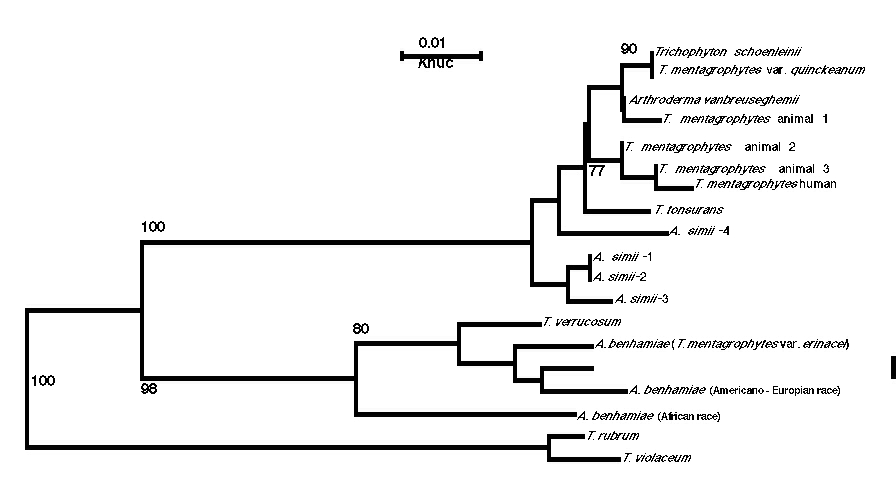This site was created as an undergraduate course requirement at Davidson College
Trichophyton
Life Cycle
Trichophyton or ringworm is the keratinophilic fungus that causes the common diseases called athlete’s foot and jock itch. It is characterized as mycelia that have a mesh of elongated and branched filamentous hyphae. It is categorized as a dermatophyte or fungi imperfecti because its sexual life cycle is still unclear to researchers. Trichophyton most commonly reproduces asexually through septatic or thin membrane-like hyphae that form reproductive spores. These spores, called conidiophores, are constructed “naked” and usually in rows on the conidiospores. Conidiosphores are braches of mycelium (Stevenson 2007). A distinguishing visual characteristic is that these spores form grape-like clusters. Trichophyton are multicelluar with smooth, thin walls in a cigar-like (called clavate) shape (Oyeka 2000).

Figure 2. Taxonomy Tree of Trichophyton. This is a genomic taxonomy tree of Trichophyton. The numbers at the branching correspond to the degree of change and the length will tell you how different the genomes are. (http://www.pfdb.net/index.html)
Trichophyton is classified as saprophytic (decomposer) and parasitic towards its host. It is an anthrophilic species meaning that its only natural hosts are human cells. It is most often found on the feet, especially between the digits with or without lesions. It is estimated that roughly 1/3 of cases are asymptomatic. During the first 48 hours of infection, in vitro, the Trichophyton is undetectable, but is considered to be in its logarithmic phase. Trichophyton uses a variety of acid proteases, elastases, and keratinases to invade the epidermis or skin cells. The fungus remains in the stratum corneum of the skin, which is hypothesized why it is so frequent, chronic, and so hard to treat. The lack of vascularity in this layer of the epidermis doesn’t allow the immune system to fight effectively once beyond the physical barrier of the skin (DoctorFungus 2007)
The growth rate and phase depends on the presence of nutrients in the environment. In one study, adherence and germination was observed within 6 hours of incubation and small colonies forming by 24 hours. By 48 hours the mycelium were well formed and developed (Oyeka). Without the necessary nitrogen, carbon, and sulfur for the Trichophyton metabolism and diet, the organism enters the log phase, where the fungus degrades the keratin of the stratum corneum to form the necessary amino acids and thus proteins for growth and reproduction. Once a sufficient supply is made the Trichophyton organism enters the stationary phase where it no longer is in a rapid degradation rate. It enacts its proteases to degrade the keratinocytes to sustain life. This destruction of epidermal cells and the immune response is what causes the irritation and soreness associated with athlete’s foot (Apodaca 1989).
Evasion of Immune System Detection
For more information, please refer to the
Davidson College Biology Home Page
E-mail me any comments or concerns
© Copyright 2007 Department of Biology, Davidson College, Davidson, NC 28035